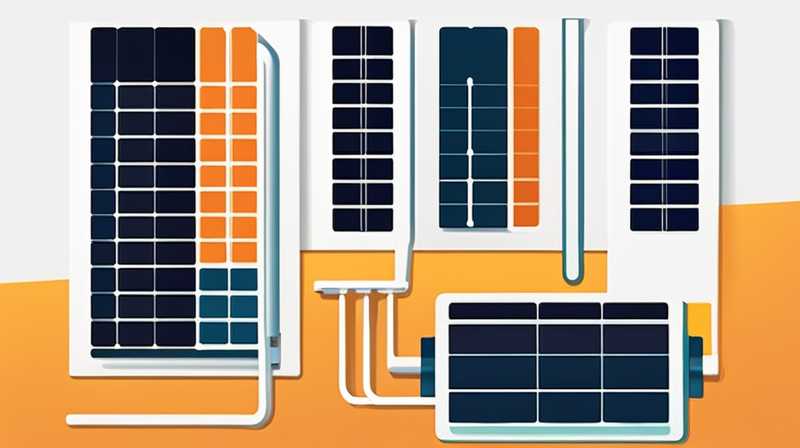
To efficiently stack solar cells for charging, one must consider several critical aspects, including 1. Arrangement configuration, 2. Electrical connectivity, 3. Thermal management, 4. Productivity optimization. Each of these points contributes significantly to maximizing the efficiency and functionality of solar energy systems.
1. ARRANGEMENT CONFIGURATION
When arranging solar cells for optimal engagement, one must reflect on the physical layout strongly. Vertical and horizontal stacking both have their merits based on the available space and intended application. Vertical stacking allows for a reduced footprint, making it useful in limited areas. Conversely, horizontal arrangements can disperse weight more effectively and may be easier for maintenance.
A systematic configuration also ensures that light exposure is maximized. In multi-layer setups, it is vital that each layer receives sufficient sunlight. For instance, incorporating semi-transparent solar cells enables the underlying layers to benefit from the excess light. This arrangement enhances energy production, especially in locations where shadows or obstructions are commonplace.
2. ELECTRICAL CONNECTIVITY
Effective electrical design is pivotal. Individual solar cells must be interconnected in series or parallel configurations to enhance voltage output or current capacity, respectively. Series connections are advantageous for reaching higher voltage levels, making them suitable for long-distance transmission. In contrast, a parallel arrangement can increase the overall current and provide redundancy. This means that if one cell underperforms, others can still contribute to the system’s energy output.
Moreover, the choice of wiring and connectors impacts efficiency. Utilizing high-quality materials ensures minimal energy loss due to resistance. Specialized cables are available that are designed to withstand outdoor conditions while minimizing potential degradation over time.
3. THERMAL MANAGEMENT
Solar cells are susceptible to performance losses at elevated temperatures. As such, thermal management systems must be integrated into the stacking design. This can be achieved through the incorporation of heatsinks or ventilation solutions that promote cooling.
Understanding the thermal characteristics of materials and how they interact is critical. Some innovative systems utilize phase-change materials that can absorb excess heat and release it when temperatures drop. This allows for consistent cell performance regardless of environmental fluctuations, thereby ensuring longevity.
4. PRODUCTIVITY OPTIMIZATION
To maximize productivity, regular monitoring and maintenance are essential. Implementing smart technologies, such as IoT sensors, can provide real-time data on performance metrics. These insights can assist in an efficient diagnosis of any shortcomings or inefficiencies within the system.
In addition, optimizing the angle of the stacked cells relative to the sun’s position is vital. The use of adjustable mounts offers the flexibility to change orientations according to seasonal variations, improving energy capture.
FAQs
WHAT IS THE BEST CONFIGURATION FOR STACKING SOLAR CELLS?
The optimal configuration for stacking solar cells largely depends on the available space and specific energy goals. Vertical stacking is typically ideal for maximizing energy production in limited areas, allowing for increased density without consuming a large footprint. On the other hand, horizontal configurations can be more practical for accessibility and maintenance. Both configurations should also consider light exposure and shading impacts, as proper orientation is crucial. Furthermore, integrating semi-transparent cells in a layered approach can enhance vertical designs by allowing for light penetration to lower levels. Ultimately, it may also be beneficial to conduct site assessments and simulations to identify the most advantageous arrangements to achieve desired energy outputs.
HOW CAN I MINIMIZE HEAT LOSS IN SOLAR CELL STACKING?
Minimizing heat loss involves incorporating effective thermal management solutions within the design. Utilizing heatsinks is one approach, as they can dissipate heat away from the solar cells, maintaining operational temperatures. Additionally, ventilated designs can promote airflow around the cells, reducing temperatures naturally. Phased-change materials can also play a role; they absorb excess heat during peak conditions and release it when temperatures decrease. Regular maintenance checks ensure no dust or debris obstructs airflow, contributing to performance efficiency. By focusing on material choices and implementing systematic cooling techniques, one can significantly reduce heat-related losses in stacked solar cell designs.
WHAT ADVANTAGES DOES STACKING SOLAR CELLS PROVIDE?
Stacking solar cells offers multiple advantages that align with energy production goals. First, it maximizes energy capture by utilizing vertical space, allowing configurations to generate increases in overall power output without needing more land. Second, it can facilitate easier scalability, enabling the addition of layers as energy needs grow. Additionally, innovative stacking designs often incorporate performance-enhancing technologies such as bifacial layers that can harness sunlight from multiple angles. Lastly, well-designed stacks can reduce the overall installation footprint, making them suitable for urban environments where land is limited. These benefits contribute to the growing attractiveness of solar technologies in both residential and commercial applications.
To effectively harness solar power through stacked cells, an intricate understanding of various factors is crucial. This includes considering how the physical arrangement impacts efficiency, ensuring robust electrical connections are made, prioritizing effective thermal management, and employing strategies that enhance productivity. Emphasizing quality in each of these domains not only amplifies energy output but also extends the lifespan of the solar energy system. By combining innovative design approaches with an eye for detail, one can ensure optimal performance and reliability in solar cell stacking endeavors.
Original article by NenPower, If reposted, please credit the source: https://nenpower.com/blog/how-to-stack-solar-cells-for-charging/


